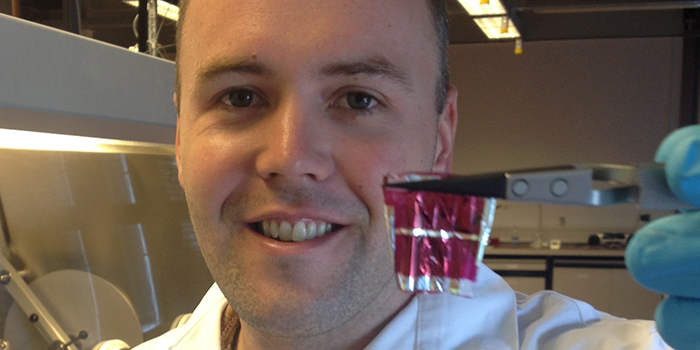RII-Track 4: Digital Alloy Contact Layers for Solar Cells:
EPSCoR Research Fellow: Matthew White
EPSCoR Research Fellow: Matthew White

Assistant Professor Matthew White of the UVM Department of Physics and Materials Science Program

1. Larsen, A., Dahal, E., Paluba, J., Cianciulli, K., Isenhart, B., Arnold, M., Du, B., Jiang, Y., and White, M. S. “Nonlinear Impedance Spectroscopy of Organic MIS Capacitors and Planar Heterojunction Diodes” Organic Electronics 62, (2018): 660–666. doi:10.1016/j.orgel.2018.07.003
During the summer of 2018, Assistant Professor Matthew White of the UVM Department of Physics and Materials Science Program and one graduate research assistant traveled to Golden Colorado to spend three months working with global leaders in perovskite solar cells at the National Renewable Energy Laboratory (NREL). Three UVM undergraduate physics majors joined them, with travel supported by the UVM Clean Energy Fund. The team used Pulsed Laser Deposition (PLD) to construct digital alloy oxide films with precise energy band and doping gradient control. These digital alloys were used as electron-selective contact layers for perovskite solar cells to simultaneously maximize the charge collection efficiency and prevent carrier recombination, improving both the short circuit current and open circuit voltage, as seen in the solar cell J-V curves below. Doing so requires precise, sub-monolayer control of both isovalent substituent (Mg) and dopant (Ga) concentration in an intrinsic ZnO host matrix. PLD offers an ideal tool for digital alloy fabrication as the laser pulses occur on the order of 1 to 10 per second, each depositing a small fraction of a monolayer of material. By switching targets between laser pulses, we fabricated such digital alloy gradient thin films. The tools necessary to fabricate and characterize such advanced nanomaterials are only available at NREL. A publication entitled “Digital alloy contact layers for solar cells” is currently in preparation summarizing the results of our summer research. An additional publication entitled “Nonlinear impedance spectroscopy of organic MIS capacitors and planar heterojunction diodes”, based on our preparatory work during spring 2018, was published in Organic Electronics.[1] The work was also presented at the Materials Research Society Fall 2018 meeting in Boston, MA.
Award Abstract #1738575